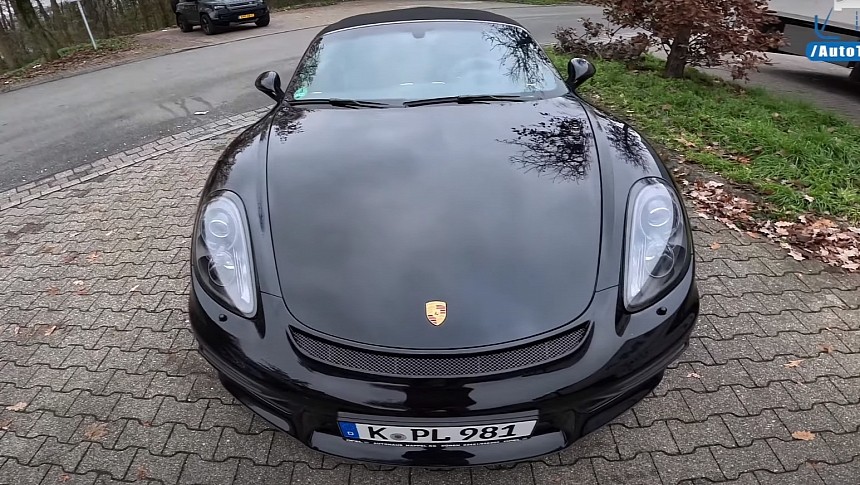Most modern cars can go up to 124 mph (200 kph). That wasn't the case 30 or 40 years ago. But things become slightly more complicated when aiming for the magical 186.41 mph (300 kph) barrier.
You need a car with a good drag coefficient, an engine with enough power, a proper drivetrain setup, and a stable chassis. Naturally, the driver must be up to the job, too, as things can go wrong fast at those speeds. Sneezing will have you shutting your eyes involuntarily for about half a second. You'll travel 131 feet (40 meters) at that speed without seeing in front of you.
If that's not terrifying, I don't know what is. And yet, there's one man who has been performing these tests on the Autobahn for years and years now. Making a living out of pushing cars to their limit on a road sector with no speed limit could be a lot of fun if you can handle the pressure. In today's exercise, the plan is to see how fast the Porsche 981 Spyder can go. When Porsche introduced the third-generation Boxster, the nameplate had been around for about 15 years.
In the early days, the most potent 986 featured a 3.2-liter engine with just over 250 horsepower. That was enough to technically propel the sub-3,000 lbs (1,360 kg) sports car to speeds of 164 mph (264 kph). Fast forward to the car in the video; engine displacement has increased to 3.8 liters. This unit provided roughly 370 horsepower and 310 lb-ft (420 Nm) of torque.
Power goes to the rear wheels only via a six-speed manual transmission, and the people at Porsche claimed a top speed of 180 mph (290 kph). With all the traffic going on, you can't always extract the most out of a car the first time around. If someone merges in your lane without adequately checking their mirrors, you must always be ready for heavy braking.
Not only does that put you in a dangerous situation on the spot, but the police can even take drastic action against you for causing an accident while driving at high speeds. Not having an official speed limit on specific road sectors does not mean the authorities encourage people to put the pedal to the metal; on the contrary. After several attempts, the best result the driver can get is 168 mph (271 kph).
That's slightly less than the car is technically capable of, but "some juice" still remains in it. High-speed runs are not what Porsche engineers had in mind for this car. It's better suited to take you out for a relaxed drive along the coast, as opposed to what you'd expect from its more raw siblings, such as the GT3 RS or the 911 Turbo S. But it's still pretty damn fast by any standard!
If that's not terrifying, I don't know what is. And yet, there's one man who has been performing these tests on the Autobahn for years and years now. Making a living out of pushing cars to their limit on a road sector with no speed limit could be a lot of fun if you can handle the pressure. In today's exercise, the plan is to see how fast the Porsche 981 Spyder can go. When Porsche introduced the third-generation Boxster, the nameplate had been around for about 15 years.
In the early days, the most potent 986 featured a 3.2-liter engine with just over 250 horsepower. That was enough to technically propel the sub-3,000 lbs (1,360 kg) sports car to speeds of 164 mph (264 kph). Fast forward to the car in the video; engine displacement has increased to 3.8 liters. This unit provided roughly 370 horsepower and 310 lb-ft (420 Nm) of torque.
Power goes to the rear wheels only via a six-speed manual transmission, and the people at Porsche claimed a top speed of 180 mph (290 kph). With all the traffic going on, you can't always extract the most out of a car the first time around. If someone merges in your lane without adequately checking their mirrors, you must always be ready for heavy braking.
Not only does that put you in a dangerous situation on the spot, but the police can even take drastic action against you for causing an accident while driving at high speeds. Not having an official speed limit on specific road sectors does not mean the authorities encourage people to put the pedal to the metal; on the contrary. After several attempts, the best result the driver can get is 168 mph (271 kph).
That's slightly less than the car is technically capable of, but "some juice" still remains in it. High-speed runs are not what Porsche engineers had in mind for this car. It's better suited to take you out for a relaxed drive along the coast, as opposed to what you'd expect from its more raw siblings, such as the GT3 RS or the 911 Turbo S. But it's still pretty damn fast by any standard!







